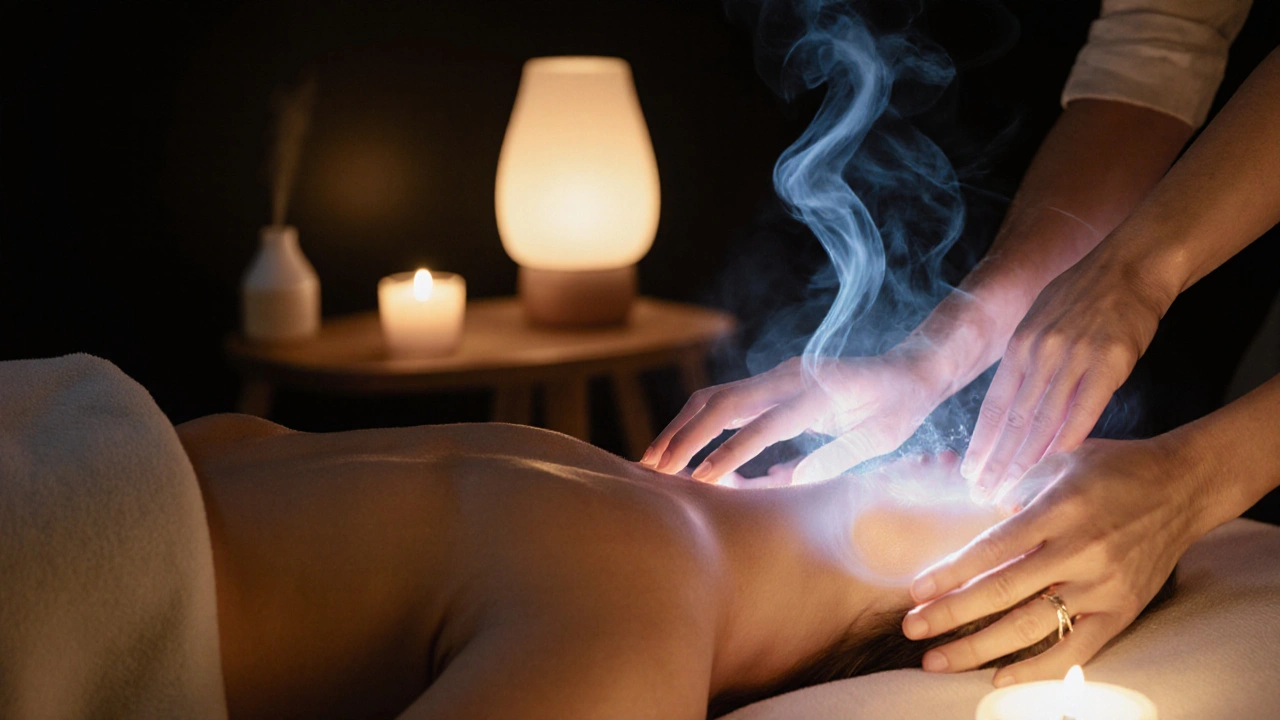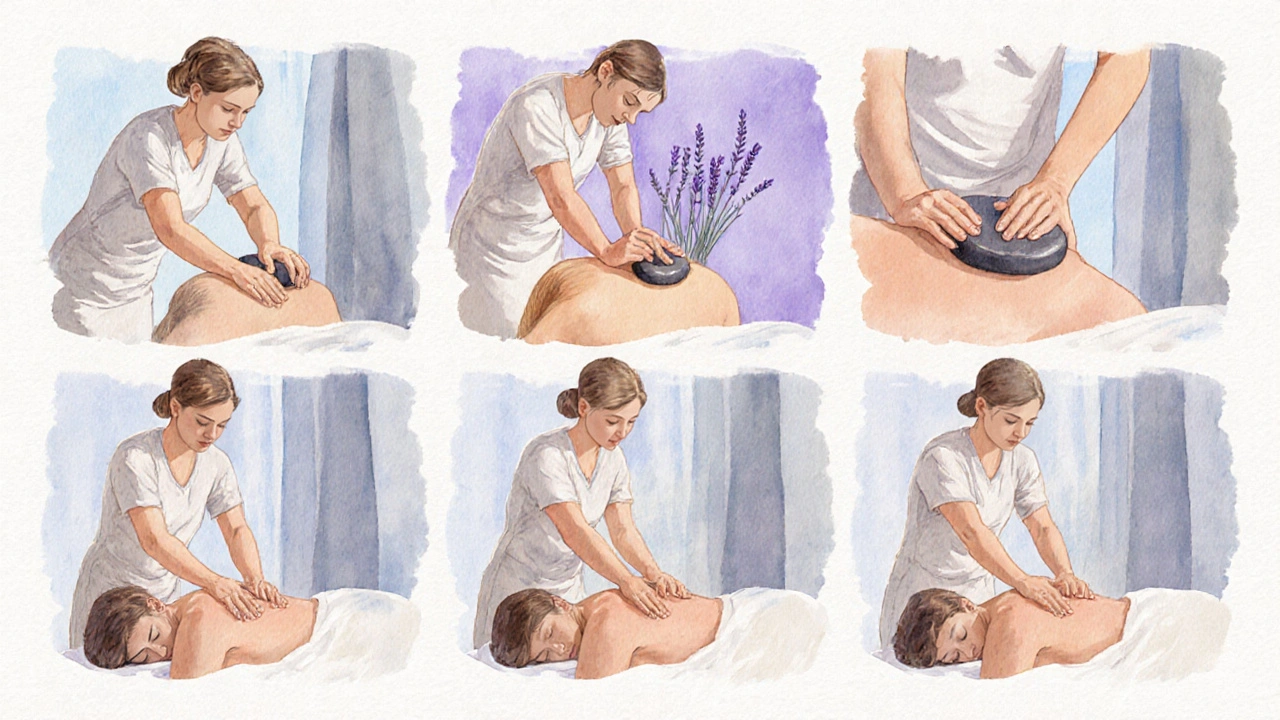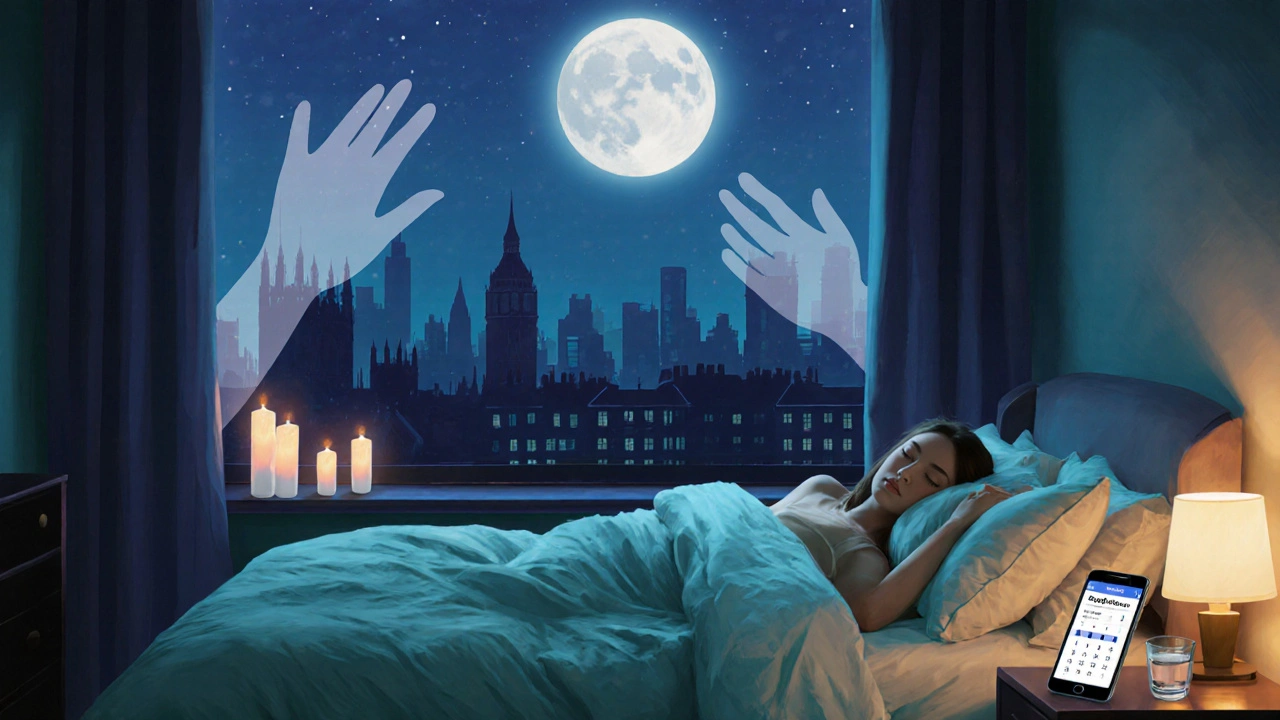Discover how body massage can improve sleep quality, the best techniques, pricing, safety tips, and where to find trusted therapists in London.

- Created by: Liam Redgate
- Completed on: 16 Oct 2025
- Categories: Body Massage
Quick Takeaways
- Massage lowers cortisol and boosts melatonin, helping you fall asleep faster.
- Swedish and deep‑tissue massages are best for relaxing tight muscles before bed.
- Typical sessions cost £50‑£90 for an hour in London and can be booked online.
- Safe practices include checking therapist credentials and avoiding intense pressure right before sleep.
- Combine massage with a calm bedtime routine for the biggest sleep‑quality gains.
Direct Answer
If you’re tossing and turning, a body massage can be a game‑changer. By easing muscle tension, reducing stress hormones, and stimulating the parasympathetic nervous system, a good massage prepares your body for deep, restorative sleep.
Comprehensive Guide to Body Massage and Better Sleep
Ever notice how a simple rub‑down after a long day makes you feel drowsy? That’s not magic - it’s science. In this guide we’ll walk through what body massage is, why it matters for sleep, which techniques work best, and how to find a reliable therapist in London.
Definition and Context
Body Massage is a therapeutic practice that involves manual manipulation of muscles, tendons, and soft tissue using pressure, strokes, and kneading. It aims to relieve tension, improve circulation, and promote overall well‑being. Meanwhile, Sleep Quality refers to how efficiently you fall asleep, stay asleep, and wake up feeling refreshed. Poor sleep is linked to higher cortisol levels, reduced melatonin, and a sluggish parasympathetic response.
How Body Massage Improves Sleep
Three key physiological shifts happen during a good massage:
- Hormone balance: Pressure reduces cortisol (the stress hormone) and raises serotonin, which the brain converts to melatonin - the sleep hormone.
- Parasympathetic activation: Gentle strokes trigger the “rest‑and‑digest” branch of the nervous system, lowering heart rate and preparing the body for rest.
- Muscle relaxation: Tight muscles release built‑up lactic acid, easing aches that can keep you awake.
Research from the Journal of Sleep Research (2023) showed participants who received a 45‑minute Swedish massage before bed fell asleep 23% faster and enjoyed 15% more deep‑sleep stages.

Benefits of Body Massage for Sleep
- Faster sleep onset: Lower cortisol means fewer racing thoughts.
- Longer REM cycles: Better circulation supplies the brain with oxygen, supporting dream sleep.
- Reduced night‑time awakenings: Relaxed muscles lessen pain‑related disruptions.
- Improved mood: Endorphin release lifts spirits, reducing anxiety that often delays sleep.
Types of Body Massage That Boost Sleep
Not all massages are created equal for bedtime. Here’s a quick rundown of the most sleep‑friendly techniques you’ll find in London:
- Swedish Massage: Long, flowing strokes that enhance overall relaxation - ideal for beginners.
- Deep Tissue Massage: Focuses on stubborn knots; best for chronic tension but should be done earlier in the evening.
- Aromatherapy Massage: Uses essential oils like lavender or chamomile to amplify calming effects.
- Hot Stone Massage: Warm stones melt muscle stiffness, creating a soothing heat that promotes sleep.
- Lymphatic Drainage Massage: Gentle, rhythmic movements that reduce fluid buildup, helping you feel light before bed.
How to Find Body Massage Services in London
London offers a dense network of licensed therapists. Follow these steps to choose a trustworthy provider:
- Search reputable directories such as Massage London or the UK Register of Massage Therapists.
- Look for certifications - Level3 Diploma in Massage Therapy is a good baseline.
- Read recent client reviews; focus on comments about “sleep improvement” or “relaxation”.
- Check the therapist’s specialisations - many list “sleep‑focused massage” in their profiles.
- Contact the clinic to ask about evening availability; a 30‑minute pre‑bed session is often offered.
What to Expect During a Session
First, the therapist will discuss any aches, preferred pressure, and your bedtime routine. You’ll lie on a comfortable table, covered with a sheet, and the room will be dimmed with soft music. The massage typically lasts 45‑60 minutes, using oil or lotion to reduce friction. Towards the end, the therapist may apply light, rhythmic strokes to signal the body to shift into a restful state. After the session, you’ll be given a few minutes to sit up slowly - this transition helps lock in the calm.

Pricing and Booking
London rates vary by location and therapist experience:
- Standard 60‑minute Swedish massage: £50‑£70.
- Deep tissue or hot stone: £70‑£90.
- Specialised “Sleep‑Boost” packages (including aromatherapy): £80‑£110.
Most clinics allow online booking via their websites or through platforms like Treatwell. Book at least 24hours in advance for evening slots.
Safety Tips
- Verify the therapist’s licence and insurance before the first session.
- Avoid deep‑tissue pressure within two hours of bedtime if you’re sensitive to soreness.
- Inform the therapist of any medical conditions - recent surgeries, skin infections, or pregnancy require modifications.
- Stay hydrated after the massage to help flush out metabolic waste.
- If you feel dizzy or unusually fatigued, let the therapist know immediately.
Comparison Table: Body Massage vs. Aromatherapy Massage for Sleep
| Aspect | Body Massage (e.g., Swedish) | Aromatherapy Massage |
|---|---|---|
| Primary Technique | Long, smooth strokes | Strokes + essential oils |
| Key Sleep‑Boosting Factor | Muscle relaxation & cortisol drop | Oil aromatics (lavender) + muscle relaxation |
| Typical Duration | 45‑60min | 60‑75min |
| Average Cost (London) | £55‑£70 | £80‑£110 |
| Best Time Before Bed | 30‑45min prior | 45‑60min prior |
FAQ: Your Sleep‑Massage Questions Answered
Can a massage replace my bedtime medication?
Can a massage replace my bedtime medication?
Massage can reduce the need for mild sleep aids by lowering stress hormones, but it shouldn’t replace prescribed medication without consulting a doctor.
How soon after a massage can I go to sleep?
How soon after a massage can I go to sleep?
Aim for 20‑30 minutes of quiet time after the session. This lets the body settle into the parasympathetic state.
Is it okay to have a massage every night?
Is it okay to have a massage every night?
For most people, a gentle sleep‑focused massage 3‑4 times a week is safe. Daily deep tissue can cause soreness if you don’t allow recovery.
Do I need to shower before a body massage?
Do I need to shower before a body massage?
A quick shower is recommended to remove sweat or lotions, but you don’t need a full bath - the therapist will cleanse the area with warm towels.
Will massage help me stay asleep through the night?
Will massage help me stay asleep through the night?
Yes, by reducing muscle pain and stress, massage can lower the chance of waking up due to discomfort, leading to longer continuous sleep.
Ready to Try?
If you’re fed up with restless nights, book a sleep‑focused body massage this week. A calm body and mind are just a session away from better sleep.
Deep tissue massage has gone from a secret weapon for athletes to a must-try for anyone slouching over a desk all day. This article breaks down exactly how deep tissue massage targets your muscles and helps you stand taller—without the pain some expect. You’ll learn how it works, the types of treatments you’ll find, what a session really feels like, and how to pick the right therapist. We’ll also dig into safety must-knows and cover how massage stacks up against other posture fixes. Got posture issues? This guide could change the way you think about massage.
Feeling stiff or burned out? Regular massage sessions near you are more than just a treat—they can boost your mood, cut stress, and even help with pain relief. This guide breaks down the real-life benefits of booking a local massage, what to expect, and how to choose the right service. You'll also find tips for keeping your sessions safe and affordable. Ready to upgrade your self-care routine?



Aditya Sinha
October 16, 2025 AT 13:43Yo, my roommat swears by nighty massages, u should try it 2.
Ben Görner
October 16, 2025 AT 13:53Thanks for sharing this detailed guide! I’ve found that scheduling a 45‑minute Swedish massage about an hour before bedtime really helps me wind down. It’s also a good idea to stay hydrated afterward, as the post mentions, because water helps flush out the metabolic waste released during the session. If you’re new to massage, look for therapists with a Level 3 Diploma and read recent reviews focusing on “sleep improvement”. Lastly, remember to give yourself a few minutes of quiet time after the session before hitting the pillow – it lets your parasympathetic system take over smoothly.
Vinayak Agrawal
October 16, 2025 AT 14:03Absolutely! I’m all about that pre‑sleep grind – a quick 30‑minute deep‑tissue session can melt away the day’s stress like butter on toast. Just make sure you pick a therapist who knows the “sleep‑boost” technique, and you’ll feel the difference the very next night. Trust me, staying consistent 3‑4 times a week will sky‑rocket your sleep quality. Let’s get those muscles relaxed and the mind quiet – you’ve got this!
Sana Siddiqi
October 16, 2025 AT 14:13Oh wow, thanks for the groundbreaking insight, absolutely never heard of “massage for sleep” before. Maybe you should write a book titled “Massage 101 for Dummies Who Can’t Sleep”. Anyway, if you’re looking for recommendations, the article already lists the best types – Swedish, deep‑tissue, aromatherapy. Just don’t expect miracles without proper timing and a legit therapist.
Bethany Wappler
October 16, 2025 AT 14:23Reading through the guide, one cannot help but notice the elegant interplay between physiological science and the timeless quest for restorative rest.
It reminds me of the ancient philosophers who argued that the health of the soul is inseparable from the health of the body.
Modern research, as cited, shows that a simple 45‑minute Swedish massage can shave off a quarter of the time it takes to drift into slumber.
Such a finding is not merely a statistical footnote; it is a testament to the power of touch in re‑balancing our neuroendocrine pathways.
When cortisol levels dip and serotonin rises, the brain dutifully converts the latter into melatonin, the very hormone that ushers us into deep sleep.
The article wisely advises against intense deep‑tissue work within two hours of bedtime, for muscle soreness can paradoxically trigger sympathetic arousal.
Indeed, the parasympathetic “rest‑and‑digest” system thrives on gentle, rhythmic strokes that signal safety to the nervous system.
Aromatherapy, especially with lavender or chamomile, adds an olfactory dimension that can further calm the mind, a fact the guide highlights in its comparative table.
From a practical standpoint, booking a qualified therapist-someone with a Level 3 Diploma and proper insurance-cannot be overstated.
The often‑overlooked step of reading client reviews for mentions of sleep improvement can save one from a sub‑par experience.
Hydration after the session, as suggested, assists in flushing metabolic waste, which might otherwise linger and cause discomfort.
Moreover, allocating a quiet 20‑30 minute buffer before actually climbing into bed allows the parasympathetic response to plateau.
In my own routine, I pair a light Swedish massage with a brief meditation, and I have observed a marked increase in both sleep onset speed and REM duration.
While massage is not a panacea that should outright replace prescribed sleep medication, it can certainly reduce reliancee on mild hypnotics for many individuals.
Thus, integrating regular, sleep‑focused massage into one’s hygiene practices represents a holistic, low‑risk strategy for better nightly recovery.
In short, treat the body as a temple, and let skilled hands be the caretakers that usher you into the restorative realm of sleep.
Maria Biggs
October 16, 2025 AT 14:33Well, that was a lofty essay, but let’s get real – most people won’t bother reading a dissertation just to book a massage. 🙄 You’re basically telling folks to spend £80 on “sleep‑boost” packages without considering the average budget. The data you cite is cherry‑picked, and the suggested routine sounds like a marketing gimmick. If you actually want measurable results, start with a basic Swedish session and track your sleep with a simple app before splurging on aromatherapy. Otherwise, you’re just peddling hype.